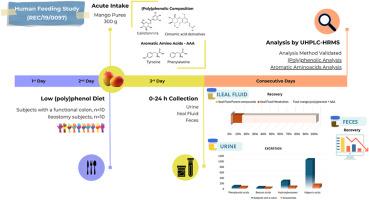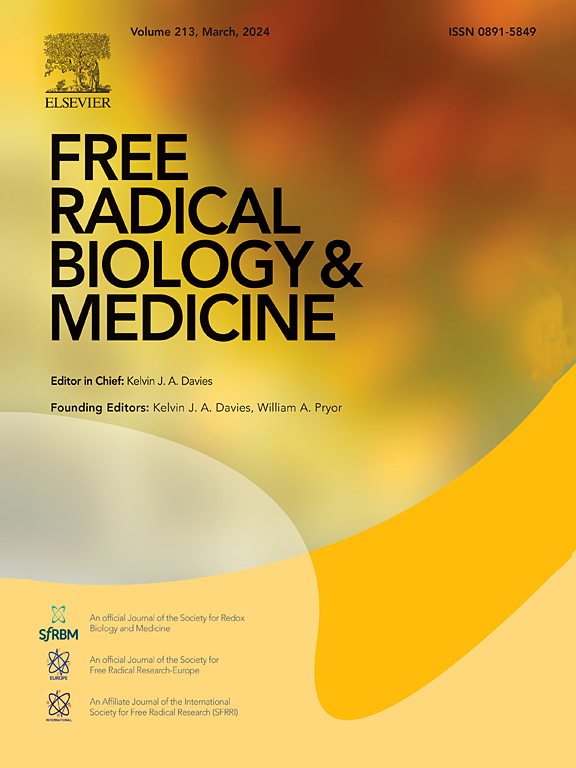芒果(多)酚的生物利用率:评估结肠、苯丙氨酸和酪氨酸对产生酚类代谢产物的影响。
IF 7.1
2区 生物学
Q1 BIOCHEMISTRY & MOLECULAR BIOLOGY
引用次数: 0
摘要
通过手术切除结肠的回肠造口者和全胃肠道(GI)受试者摄入芒果果肉泥,然后在 24 小时内收集回肠液、尿液和粪便,并通过超高效液相色谱-氢谱-质谱(UHPLC-HR-MS)进行分析。果泥中的主要(多)酚类物质是五倍子单宁(356 μmol)和两种羟基-甲氧基-肉桂酰葡萄糖酯(43 μmol),以及芳香族氨基酸苯丙氨酸(22 μmol)和酪氨酸(209 μmol)。回肠液分析表明,几乎所有摄入的五倍子单宁似乎都在上消化道中分解,释放出的苯甲酸被迅速吸收进入循环系统,然后主要作为第二阶段代谢物排出尿液。同样,肉桂酸共轭物的葡萄糖分子也被裂解,释放出的肉桂酸从近消化道有效吸收,并在排泄前进行第二阶段代谢。摄入芒果后排出的主要酚类物质包括苯乙酸、苯甲酸和羟苯代谢产物,这些物质在回肠造口术患者的尿液中含量较低,但也相当可观。这表明,这些酚类物质(包括羟苯衍生物)有一部分来自上消化道吸收的底物,主要是内源性代谢产物,而不是结肠微生物群介导的分解代谢产物。1,2,3-三羟基苯(又名焦酚)是两组中最主要的尿液代谢产物。海马酸的排泄量超过了(多)苯酚的摄入量,这表明苯丙氨酸和酪氨酸在其中起了重要作用。芳香族氨基酸虽然存在于摄入的果肉中,但也有多种来源,包括膳食蛋白质在消化道内的分解,以及哺乳动物多余蛋白质在消化道外的内源性分解。该试验在临床试验网(clinical trials.gov)登记为 NCT06182540。本文章由计算机程序翻译,如有差异,请以英文原文为准。

Bioavailability of mango (poly)phenols: An evaluation of the impact of the colon, and phenylalanine and tyrosine on the production of phenolic catabolites
A mango pulp purée was ingested by ileostomists, whose colon had been removed surgically, and subjects with a full gastrointestinal (GI) tract, after which ileal fluid, urine and feces were collected over a 24 h period and analysed by UHPLC-HR-MS. The main (poly)phenols in the purée were gallotannins (356 μmol) and two hydroxy-methoxy-cinnamoyl glucose esters (43 μmol) together with the aromatic amino acids phenylalanine (22 μmol) and tyrosine (209 μmol). Analysis of ileal fluid revealed almost all the ingested gallotannins appeared to have broken down in the upper GI tract with the released benzoic acids being rapidly absorbed into the circulatory system prior to urinary excretion mainly as phase-2 metabolites. Likewise, the glucose moiety of the cinnamic acid conjugates was cleaved and the released cinnamic acids absorbed efficiently from the proximal GI tract and subjected to phase II metabolism prior to excretion. Among the main phenolics excreted after mango intake were phenylacetic and benzoic acids and hydroxybenzene catabolites which were present in lower, but none-the-less, substantial amounts, in the urine of ileostomists. This indicates that a portion of these phenolics, including the hydroxybenzene derivatives, originate from substrates absorbed in the upper GI tract and are principally products of endogenous metabolism rather than being derived from colonic microbiota-mediated catabolism. 1,2,3-Trihydroxybenzene (aka pyrogallol) was the dominant urinary catabolite in both groups. Hippuric acid excretion exceeded (poly)phenol intake indicating a significant contribution from phenylalanine and tyrosine. The aromatic amino acids, while present in the ingested pulp, can also originate from several sources including breakdown of dietary proteins in the GI tract, and endogenous breakdown of surplus mammalian proteins independent of the GI tract. The trial was registered at clinical trials.gov as NCT06182540.
求助全文
通过发布文献求助,成功后即可免费获取论文全文。
去求助
来源期刊

Free Radical Biology and Medicine
医学-内分泌学与代谢
CiteScore
14.00
自引率
4.10%
发文量
850
审稿时长
22 days
期刊介绍:
Free Radical Biology and Medicine is a leading journal in the field of redox biology, which is the study of the role of reactive oxygen species (ROS) and other oxidizing agents in biological systems. The journal serves as a premier forum for publishing innovative and groundbreaking research that explores the redox biology of health and disease, covering a wide range of topics and disciplines. Free Radical Biology and Medicine also commissions Special Issues that highlight recent advances in both basic and clinical research, with a particular emphasis on the mechanisms underlying altered metabolism and redox signaling. These Special Issues aim to provide a focused platform for the latest research in the field, fostering collaboration and knowledge exchange among researchers and clinicians.
 求助内容:
求助内容: 应助结果提醒方式:
应助结果提醒方式:


